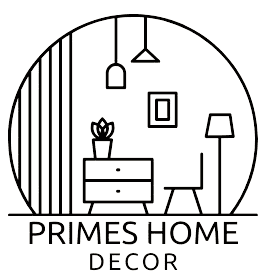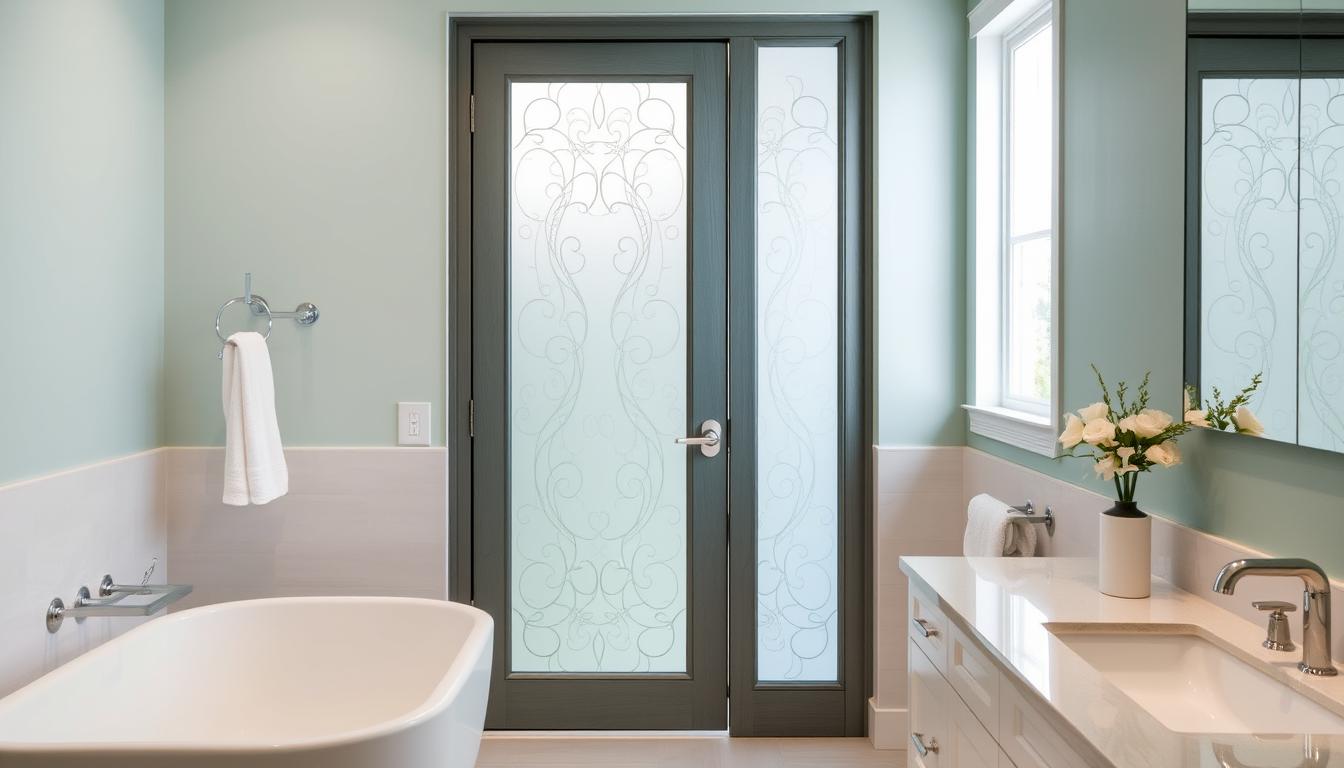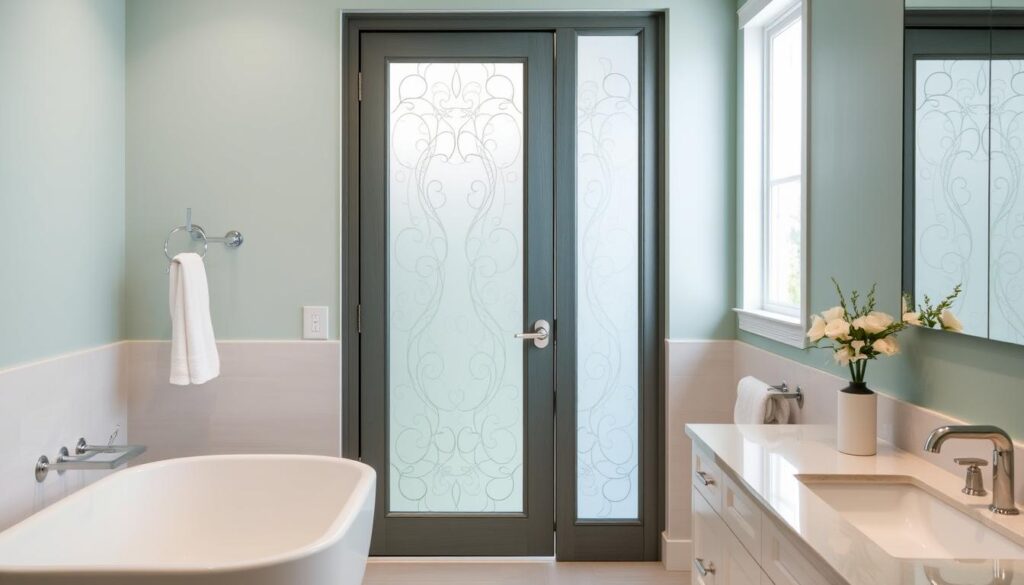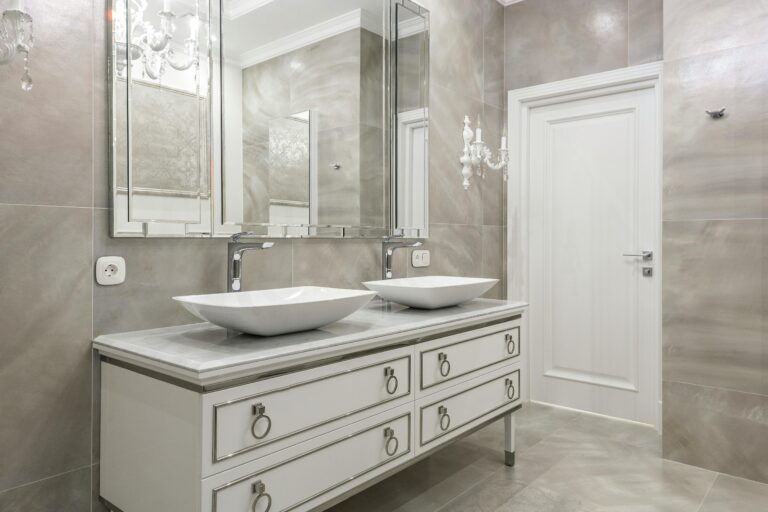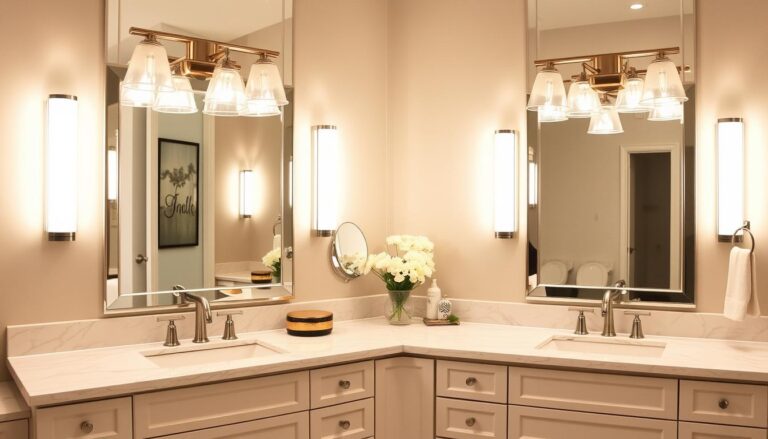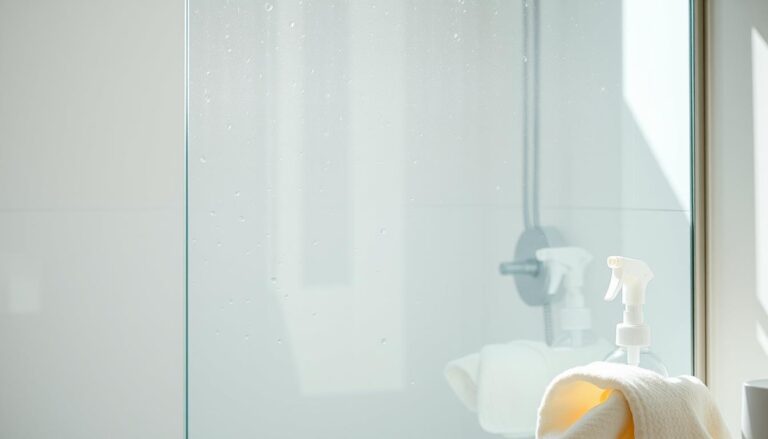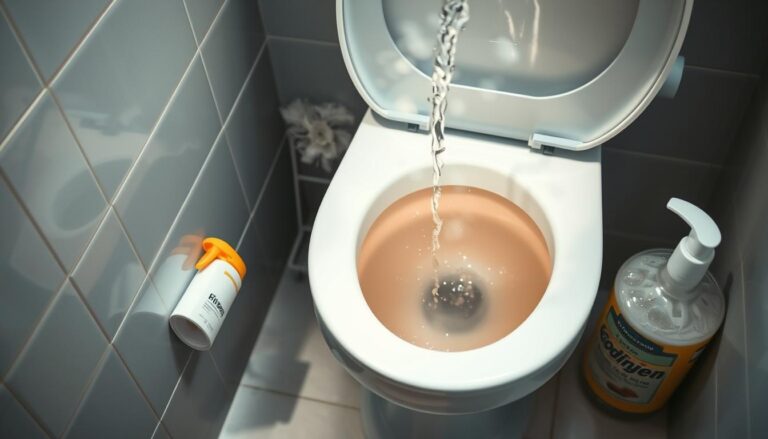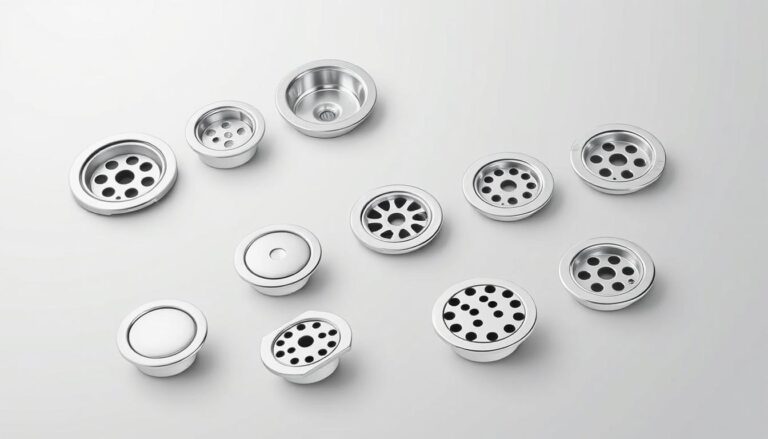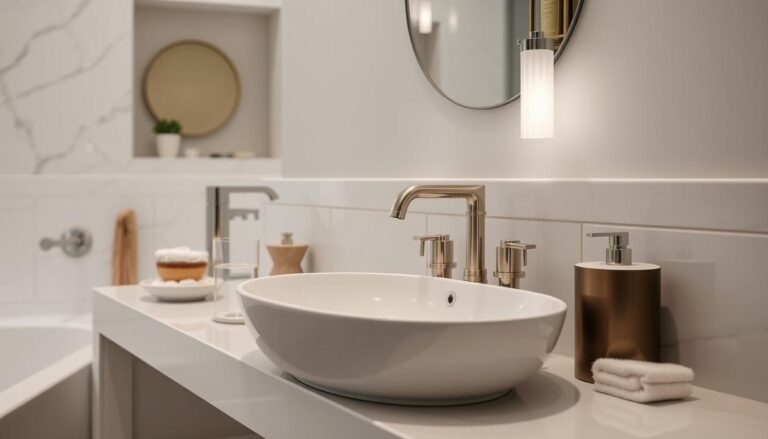Essential Guide to Choosing Your Perfect Bathroom Door
Table of Contents
Choosing the right bathroom door is more than just a practical choice. It affects privacy, design, and your home’s look. Every bathroom entrance needs careful thought to match style, function, and personal taste.
Homeowners face many challenges when picking a bathroom door. Space, moisture resistance, and design fit are crucial. The ideal door blends with your home’s look, offers privacy, and lasts long.
Knowing what bathroom doors need helps you choose wisely. You can pick from space-saving sliding doors to traditional swing doors. Each type has its own benefits for different bathroom sizes and needs.
Key Takeaways
- Bathroom doors impact privacy and room aesthetics
- Material selection determines door durability and performance
- Space constraints influence door type selection
- Consider moisture resistance for long-term functionality
- Door style should complement overall bathroom design
Understanding the Importance of a Bathroom Door
Your bathroom door does more than just block an entrance. It’s a key part in making a private space comfortable and useful. When picking a lavatory entry, knowing its role in your home’s design is important.
A good powder room door brings many benefits. It ensures privacy, blocks sound, and keeps moisture out. With many wanting a quiet bathroom, the right door can change your experience.
Benefits of a Good Bathroom Door
- Creates a private and secure space
- Reduces noise transmission between rooms
- Prevents moisture and humidity from spreading
- Enhances overall bathroom aesthetics
- Provides temperature and draft control
The Role of Privacy in Bathroom Design
Privacy is crucial in bathroom design. Your door choice affects how comfortable and safe you feel. Studies show 48% want a quiet bathroom without distractions.
Think about the door’s material, how it opens, and sound blocking. The best door mixes usefulness, style, and privacy.
Types of Bathroom Doors Available
Choosing the right washroom door is key for both looks and function in your bathroom. Different doors have their own perks, helping you save space and keep things private in your water closet entrance.
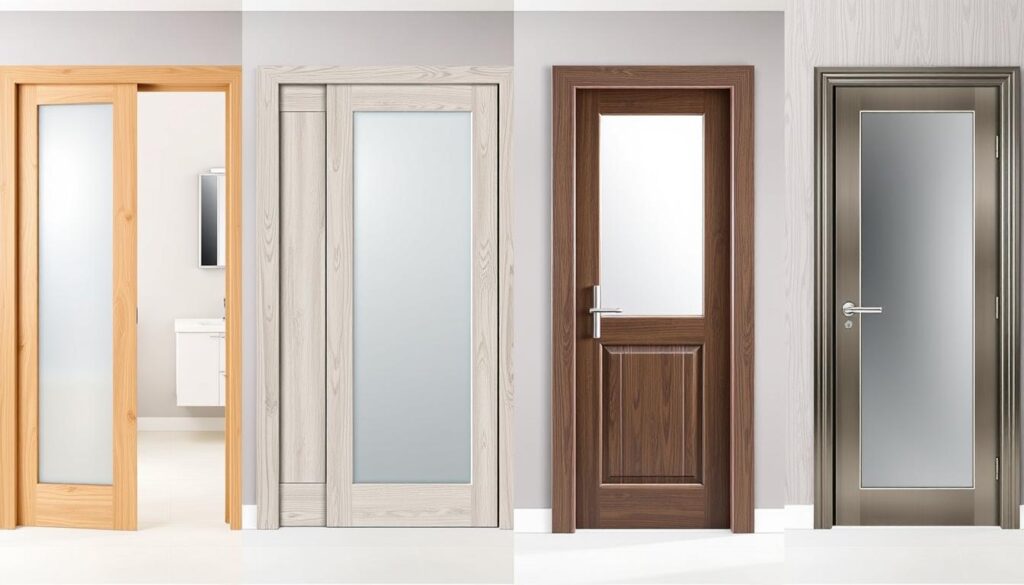
Traditional Swing Doors
Classic swing doors are still a top pick for bathroom doors. They swing open or shut, giving a timeless feel. Here’s what to think about:
- Familiar and straightforward design
- Available in various materials
- Require clear floor space for opening
- Price range: $200 – $800
Pocket Doors for Space-Saving
Pocket doors are great for small bathrooms. They slide into the wall, saving space. The benefits are:
- Maximum space efficiency
- Sleek, modern appearance
- Ideal for small bathroom layouts
- Price range: $300 – $1,500
Bi-Fold Doors and When to Use Them
Bi-fold doors are a smart choice for tight spaces. They fold together, making a small opening. They’re best for:
- Narrow bathroom entryways
- Closet-style bathroom spaces
- Areas with restricted swing room
- Lightweight and easy to install
Your choice of door depends on your bathroom’s size, layout, and style. Measure your space well before deciding.
Material Options for Bathroom Doors
Choosing the right materials for your bathroom door is key. It affects how long the door lasts, how easy it is to keep clean, and the look of your bathroom. Each material has its own benefits, fitting different styles and needs.
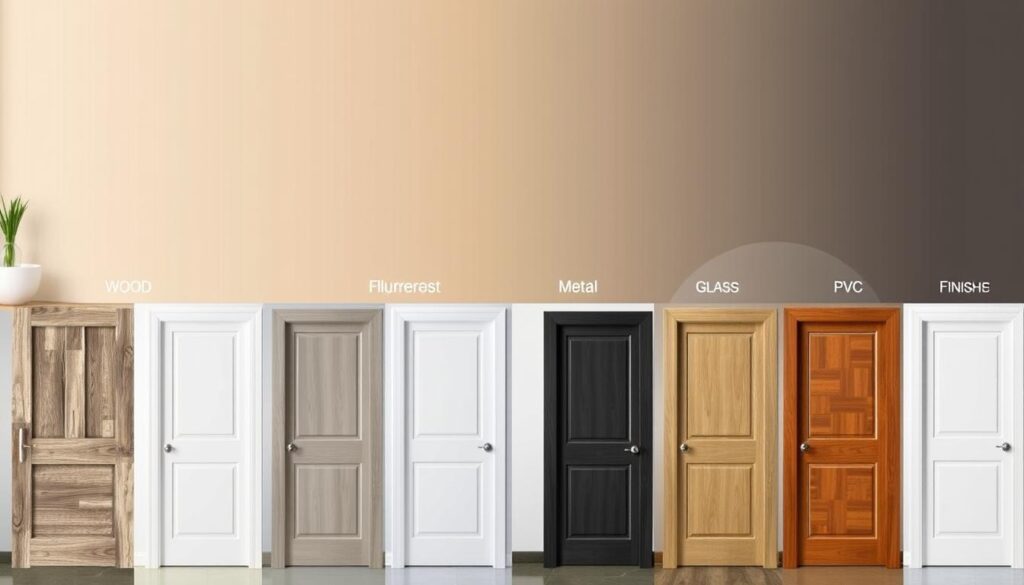
Knowing the good and bad of each material helps you pick the best for your bathroom makeover.
Wood: A Classic Choice
Wooden doors add warmth and a traditional feel to your bathroom. But, they need special care to handle moisture. New wood treatments can make them more water-resistant and durable. They’re best in well-ventilated bathrooms with controlled humidity.
Composite and MDF: Affordable Alternatives
- Cost-effective options for budget-conscious homeowners
- Excellent moisture resistance
- Lightweight and easy to install
- Available in various finishes and styles
Composite and Medium-Density Fiberboard (MDF) doors are smart choices. They don’t warp and perform well in humid places.
Glass Doors for Modern Bathrooms
Glass doors give your bathroom a modern, open feel. Frosted or textured glass adds privacy without losing style. Some glass doors also:
- Let in more light
- Look better
- Are easy to clean
- Offer many design options
When picking door materials, think about how well they handle moisture, how easy they are to care for, and your bathroom’s design.
Key Features to Consider
Choosing the right bathroom door is more than looks. It affects privacy, safety, and how well your bathroom works. Knowing what to look for can help you pick the best door for your needs.
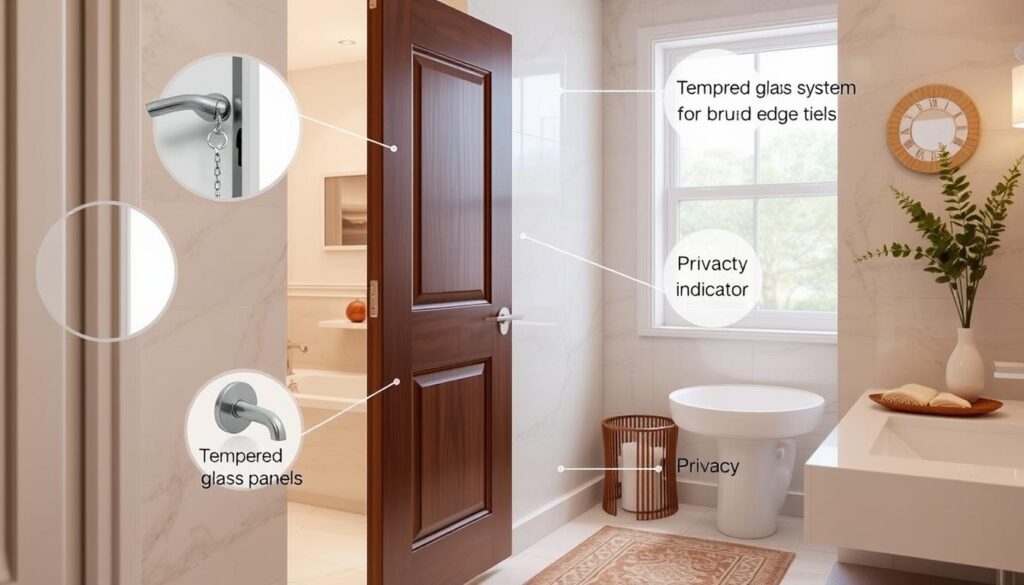
Sound Insulation for Enhanced Privacy
Privacy is key in bathrooms. Solid core doors block noise better, making your space quieter. Look for doors that keep sound out for better privacy.
Water Resistance and Durability
Bathrooms are wet places that need strong doors. Here are important features to look for:
- Moisture-resistant materials like composite or treated wood
- Sealed edges to keep water out
- Corrosion-resistant hardware
Safety Features and Child Locks
Family bathrooms need extra safety. Here are ways to make your door safer:
- Child-proof locks to stop little ones from getting in
- Smooth edges to avoid cuts
- Lever-style handles for easy use
When picking your door, think about function, safety, and looks.
Measuring for Your Bathroom Door
Choosing the right bathroom door means getting the measurements right. Knowing the dimensions is key for a space that looks and works well. Whether it’s a new door or a replacement, start with accurate measurements.
Measuring your bathroom door involves several steps for a proper fit. Here’s a detailed guide to help you begin:
How to Measure the Door Frame
- Measure the width at three points: top, middle, and bottom of the door frame
- Measure the height on both sides of the frame
- Check for any irregularities or out-of-square corners
- Use a metal tape measure for the most accurate results
Standard vs. Custom Bathroom Doors
Most bathroom doors are standard sizes, but custom doors fit unique spaces. Standard widths range from 24 to 36 inches, with 30-32 inches common. Standard heights are usually 80 inches.
- Standard door sizes fit most bathrooms
- Custom doors are best for special layouts or needs
- Wider 36-inch doors offer better access
- Remember door thickness (usually 1 3/8 to 1 3/4 inches)
Pro tip: Always double-check your measurements and think about hardware. If unsure, get help from a pro. They can guide you through the process for a perfect fit.
Choosing the Right Style for Your Bathroom
Finding the perfect bathroom door design can make your space stand out. Your bathroom door is more than just a door. It shows your style and makes your home look better.
Modern bathroom doors are more than just useful. They look great too. When picking a door style, think about a few things:
- Room size and layout
- Overall bathroom theme
- Available space for door movement
- Personal aesthetic preferences
Trending Bathroom Door Styles in 2023
This year, bathroom door designs are all about being new and flexible. Some popular styles include:
- Sliding glass doors with aluminum frames
- White oak and glass combinations
- Frosted glass doors with geometric patterns
- Minimalist frameless designs
Matching Your Door to Your Bathroom Theme
Your bathroom door should match your decor. For modern spaces, sleek sliding doors or frosted glass are good choices. Traditional bathrooms might look better with classic swing doors.
Coastal or bohemian themes are perfect for louvered doors. They let in air and add style.
Pro tip: Choose materials that can handle moisture, like PVC, aluminum, or treated wood. They keep your door looking good and working well for a long time.
Hardware and Accessories for Bathroom Doors
Choosing the right bathroom door hardware can change how your bathroom looks and works. Your door handles and accessories are key to a smooth and stylish design. They must meet both style and function needs.
- Functionality of door handles for bathrooms
- Privacy and security features
- Moisture resistance
- Design compatibility
Selecting the Right Handle and Lock
About 80% of homeowners think it’s important to pick a door knob that matches their home’s decor. Privacy locksets are the favorite for bathroom doors, with 70% of interior designers suggesting them. Spend between $50 and $150 for quality hardware that looks good and works well.
Hinges: Choosing the Proper Type
Bathroom door hardware comes in different hinge types for various door styles and weights. Here are some popular ones:
- Butt hinges for traditional doors
- Pivot hinges for heavier doors
- Concealed hinges for a sleek, modern look
When picking bathroom door hardware, look for moisture-resistant finishes and emergency release functions. About 90% of people think emergency release mechanisms are a must for bathroom doors.
Finishing Touches: Paint and Stain Options
Choosing the right colors for your bathroom doors can make a big difference. Your painted doors are not just barriers; they’re a statement of your style. They also improve the look of your bathroom.
- Room size and lighting conditions
- Existing bathroom color scheme
- Moisture resistance of paint
- Personal design preferences
Colors that Enhance Your Bathroom Aesthetics
Light colors can make small bathrooms look bigger. Soft whites, pale blues, and neutral tones are great for an airy feel. On the other hand, dark colors like navy or charcoal add a bold contrast.
Stain vs. Paint: Pros and Cons
When choosing between stain and paint, consider a few things:
- Stain keeps the wood grain and texture
- Paint lets you choose more colors
- Stains are best for high-quality wood doors
- Painted doors are easier to change colors
Tip: Use paints made for bathrooms to keep your doors looking good. They resist moisture and last longer, even with lots of use.
Installation Considerations
Choosing the right approach for bathroom door installation can save you time, money, and potential headaches. Whether you’re a DIY enthusiast or prefer professional door fitting, understanding the installation process is crucial.
Preparing for a bathroom door installation requires careful planning and the right tools. Before you begin, gather essential equipment to ensure a smooth process.
DIY Installation Tips
If you’re confident in your skills, DIY bathroom door installation can be a rewarding project. Here are key steps to help you succeed:
- Measure your doorway precisely using a tape measure
- Collect necessary tools: drill, hammer, level, screwdriver, and shims
- Check that the rough opening is square and level
- Use prehung doors for easier installation
- Have a helper assist with heavy door positioning
When to Call a Professional
Professional door fitting becomes essential in certain scenarios. Consider hiring an expert if:
- Your door frame is damaged or requires structural modifications
- You’re installing complex door types like pocket doors
- The door weight exceeds your ability to handle safely
- You lack specific carpentry skills or tools
- The bathroom layout requires precise door alignment
Professional installation ensures your bathroom door is perfectly fitted, secure, and functions smoothly. While DIY can save money, expert door fitting guarantees quality and prevents potential costly mistakes.
Maintenance of Your Bathroom Door
Keeping your bathroom door in top shape needs regular care. It’s not just about cleaning. It’s about keeping it working well and looking good for a long time.
Regular upkeep can make your bathroom door last longer. It also saves you from expensive fixes. Cleaning tips are key for those who want a clean and working bathroom.
Essential Cleaning and Care Techniques
- Inspect door hardware twice a year for potential issues
- Use stainless steel locks to resist bathroom humidity
- Lubricate locks with graphite powder or silicone spray
- Clean door surfaces weekly with appropriate cleaning solutions
- Check for signs of water damage or warping
Identifying Replacement Warning Signs
Knowing when to replace your bathroom door is important. It keeps your home looking and working well. Look out for these signs:
- Persistent squeaking or difficulty opening
- Visible warping or water damage
- Loose or damaged hinges
- Compromised lock mechanisms
- Visible mold or mildew growth
If you face complex lock issues or major damage, get a pro locksmith. Regular care stops small problems from becoming big, expensive fixes. This keeps your bathroom door in great shape for years.
Budgeting for Your Bathroom Door
Choosing the right bathroom door requires careful planning. Knowing the prices helps you invest wisely. You want quality without spending too much.
Bathroom door prices vary a lot, from $300 to $1,400. Your final cost depends on several things:
- Door material selection
- Door style and complexity
- Size of the door opening
- Custom versus standard sizing
Factors That Affect Cost
When looking for affordable doors, keep these in mind:
- Material choice greatly affects price
- Wood doors: $400 – $900
- Composite doors: $250 – $600
- Glass doors: $500 – $1,400
- Installation complexity can raise costs
- Hardware and accessories add to the total price
Finding Quality Within Your Budget
Smart homeowners can find great doors without overspending. Look for deals, compare prices, and check out seasonal sales. Opt for mid-range materials that are durable but not too expensive.
Investing in a quality door can boost your home’s value and look. Try to find a balance between cost and quality when choosing.
Eco-Friendly Options for Bathroom Doors
Choosing eco-friendly bathroom doors is a great way to make your home and the planet better. Materials like bamboo and reclaimed wood are durable and cut down on carbon emissions. Today’s eco-friendly doors are stylish, work well, and are good for the environment.
Sustainable Materials to Consider
Bamboo is a top pick for eco-friendly doors. It grows fast and takes in more carbon dioxide than trees. It’s also stronger than most hardwoods, making it perfect for bathroom doors.
Reclaimed wood and recycled materials are also good choices. They reduce environmental harm and offer high quality.
How to Choose Energy-Efficient Doors
Look for FSC or Greenguard certifications when buying eco-friendly doors. These ensure the doors meet environmental and quality standards. Even though they might cost more upfront, they save money in the long run.
Materials like cork can also save energy. They keep the bathroom temperature steady, which can lower your energy bills.
Choosing sustainable doors is more than just picking a door. It’s about supporting a circular economy and making a choice that’s good for the planet and looks great.
